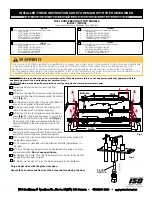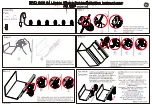
Rheonics | Switzerland | U.S.A.
SRV, SRD, SRV-FPC, SRD-FPC Installation and Intrinsic Safety Manual
P. 18
Version 2.0, Updated: October 29, 2020
Rheonics GmbH, Klosterstrasse 19, 8406 Winterthur, Switzerland
©Rheonics. Rheonics confidential and proprietary information.
Table 3: Sensor cable specifications
Parameter
Value
Minimum ingress protection (cable + connector)
IP54
Connector
M12 8 pole, A-coded, female, IP54
Twisted pair cable with a shield
4x2, shielded cable with 4 twisted pairs
Maximum length
500 m.
Minimum required conductor cross section
0.25 mm
2
Maximum practical cross section
0.5 mm
2
Maximum inductance
1.5 mH/km, per conductor
Maximum capacitance, conductor-to-conductor
220nF/km
Maximum capacitance, wire to shield
300nF/km
A commercial cable that satisfies the preceding specification is Helu Kabel type OB-BL-PAAR-CY
4x2x0.5mm
2
.
5.2.
Zener diode barriers
Each SRV/SRD must be connected to its electronics unit through Zener diode barriers as
appropriate to the installation. There are several different connection options, depending on
whether or not the SRV/SRD has a built-in Pt1000, and if so, how the Pt1000 is connected (4 or 3
wire connection). The diagrams in section below show these options.
In addition to the proper connection, the Zener diode barriers need to fulfill the electrical
specifications shown in the following tables.
The Zener diode barrier connected to the transducer coil circuit must meet the following
specifications:
Table 4: Transducer coil circuit Zener diode barrier specifications
Max. output voltage
Uo
< 7.3
V
Min. series resistance
Ro
> 9.8
Ohm
Max. output current
Io
< 730
mA
Max. output power
Po
< 1.3
W
Fuse rating
<=200
mA
This Zener diode barrier must have two channels, one for each conductor of the transducer coil
circuit.
If the Pt1000 is present in the sensor, it must be connected to one or two Zener diode barriers
with the following specification, each with two channels:















































